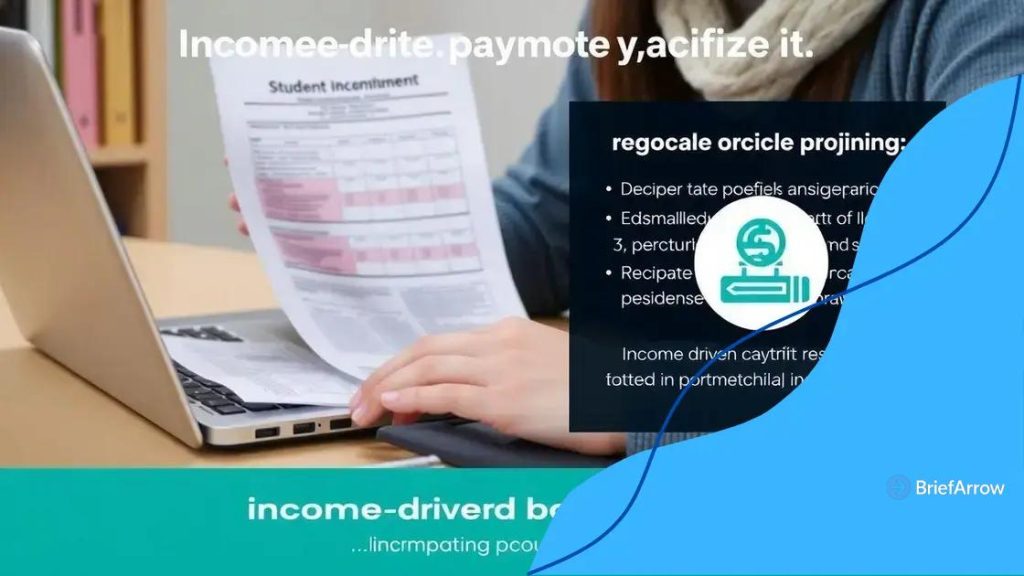Updates on income-driven repayment plan enrollment

Anúncios
Income-driven repayment plans adjust your student loan payments based on your income and family size, helping to make repayments more affordable for borrowers.
Updates on income-driven repayment plan enrollment are essential for anyone managing student loans today. With evolving policies, knowing your options can make a significant difference in how you handle repayments. Let’s dive into what you need to know to navigate these changes effectively.
Anúncios
Understanding income-driven repayment plans
Understanding income-driven repayment plans is vital for borrowers attempting to manage their student loan debt effectively. These plans offer affordable payment options based on your income, making it easier for you to stay on top of your loans.
Income-driven repayment plans can significantly lower your monthly payments by adjusting them according to your financial situation. It’s important to know how these plans work and how to apply for them.
Types of Income-Driven Repayment Plans
Several types of income-driven repayment plans are available, each designed to cater to different financial situations:
Anúncios
- Income-Based Repayment (IBR): Payments are generally capped at 15% of your discretionary income.
- Pay As You Earn (PAYE): Monthly payments are set at 10% of your discretionary income.
- Revised Pay As You Earn (REPAYE): Similar to PAYE but with additional benefits, such as interest subsidies.
- Income-Contingent Repayment (ICR): Payments are the lesser of 20% of your discretionary income or what you would pay on a fixed payment over 12 years.
Each plan has its own eligibility criteria that you must meet to enroll. It’s important to evaluate your finances and choose a plan that aligns with your current situation.
Eligibility and Application Process
To qualify for income-driven repayment plans, certain conditions need to be met. You must demonstrate a partial financial hardship, which can be shown by submitting income information.
The application process is straightforward but requires you to provide accurate information about your income and family size. Once your application is approved, your loan servicer will calculate your monthly payment based on the income-driven repayment plan you choose.
Remember, staying informed on any updates regarding these plans is crucial as they can impact your repayment journey significantly. With the right plan, you can manage your student loans more effectively and relieve financial stress.
Eligibility criteria for enrollment
Understanding the eligibility criteria for enrollment in income-driven repayment plans is essential for borrowers seeking financial relief. These criteria help determine if you qualify for reduced monthly payments based on your financial situation.
To qualify for an income-driven repayment plan, you typically must demonstrate a partial financial hardship. This means that your calculated monthly payments under a standard repayment plan are higher than what you can afford based on your income.
Basic Requirements for Enrollment
While specific requirements may vary by plan, a few general criteria apply:
- Federal Student Loans: You must have federal student loans eligible for repayment under the income-driven plans.
- Income Documentation: You’ll need to provide proof of your income, which can include pay stubs or tax returns.
- Loan Status: Your loans should be in good standing—this means you cannot be in default.
- Family Size: The number of people in your household is considered in calculating your payments.
Meeting these criteria is the first step towards obtaining more manageable payments. However, remember that your eligibility may change based on your financial situation or loan type.
Application Process
The application process involves filling out a form that includes your income details and household size. Once submitted, your loan servicer will assess your information to determine your qualification for an income-driven repayment plan.
It’s crucial to stay updated on your eligibility status, especially if your income changes. You may review your application each year or whenever significant life events occur.
Key changes in repayment options

Staying informed about the key changes in repayment options can help borrowers make the best choices for managing their student loans. Over the years, various adjustments have been made to income-driven repayment plans, affecting how payments are calculated and what benefits are available.
One significant change in repayment options is the introduction of new plans aimed at making repayments more manageable. For instance, many borrowers are now able to take advantage of lower percentage payments based on their income, which can make a big difference.
Notable Updates to Repayment Plans
Several updates have changed the landscape of student loan repayment, including:
- Payment Cap Changes: Most plans have reduced the percentage of discretionary income taken into account when calculating monthly payments.
- Forgiveness Benefits: These plans now offer improved conditions for loan forgiveness after 20 or 25 years of qualifying payments.
- Interest Rate Adjustments: Some plans have introduced interest rate caps to help mitigate the long-term growth of loan balances.
- Streamlined Enrollment Processes: The application process has become simpler, allowing borrowers to easily enroll in income-driven repayment options.
These changes are designed to provide greater flexibility and relief to borrowers. With fewer financial burdens, many borrowers can now focus on their careers and personal goals without the constant stress of repayment looming over them.
New Repayment Options Available
Several new repayment options are now on the table, each catering to different financial needs. For instance, the latest plans may offer a more gradual increase in payments as your income grows. This means less strain during the earlier years of your career, which can be crucial.
Furthermore, ongoing adjustments ensure that borrowers only pay what they can afford. This adaptability empowers individuals, allowing for adjustments according to income changes or life events. Keeping track of these updates helps you stay ahead and make informed decisions regarding your loan strategy.
Steps to enroll in the new plans
Enrolling in the new income-driven repayment plans is a straightforward process when you understand the steps to enroll in the new plans. Having the right information at hand makes it easier to navigate this important financial decision.
The first step is gathering the necessary documentation. You will need to provide proof of your income as well as details about your family size. This information is crucial for determining your eligibility for specific repayment options.
Step-by-Step Enrollment Process
Follow these steps to enroll in the new income-driven repayment plans:
- Visit the Federal Student Aid website: Start your application by going to the official website where you can find information about income-driven repayment plans.
- Complete the Application Form: Fill out the required application form. This will include personal information and details about your loans.
- Submit Income Documentation: Attach any necessary documents proving your income. This can include pay stubs, tax returns, or other verification of income sources.
- Select Your Desired Plan: Review the available options and choose the plan that best suits your financial situation. Make sure to consider your monthly budget and long-term financial goals.
After submitting your application, you will receive confirmation from your loan servicer. They will review your information and inform you of your approval status. It’s important to follow up if you do not receive a response within a reasonable timeframe.
Monitoring Your Enrollment Status
Once enrolled, keep track of your repayment status. Your payment amounts may need to be adjusted based on changes in your income. You should provide updated income information annually or whenever your financial situation changes significantly.
Staying proactive about your enrollment helps ensure that you remain in a payment plan that works for you. Remember that communication with your loan servicer is key to managing your repayment effectively.
Tips for successful repayment management
Effective repayment management is crucial for anyone participating in income-driven repayment plans. With the right strategies, you can keep your student loan payments manageable and stay on top of your finances.
One of the most important tips for successful repayment management is to regularly review your financial situation. By consistently checking your income and expenses, you can determine if your monthly payment or the plan you are on still fits your budget.
Key Strategies for Managing Repayment
Here are some strategies that can help you manage your repayments effectively:
- Set Up Automatic Payments: Many servicers offer a discount for borrowers who enroll in automatic payments. This ensures you never miss a payment while simplifying your budgeting.
- Keep Track of Changes: Monitor any changes in your income, family size, or employment status. Reporting updates promptly can help adjust your payment amount accordingly.
- Utilize Budgeting Tools: Consider using budgeting apps or tools that help you track expenses and savings. These can assist in plotting your financial roadmap each month.
- Seek Help When Needed: If you’re feeling overwhelmed, don’t hesitate to reach out to a financial advisor. They can provide personalized advice tailored to your situation.
Another effective way to manage your loans is to stay informed about any updates to the repayment plans. Changes in policies can impact your payments, so being proactive will keep you in control.
Long-Term Planning
Think about your long-term goals regarding student loans. Planning for future income changes and knowing how to adapt your repayment strategy is beneficial. Set achievable goals to pay off your loans faster, if possible. This could involve making extra payments when your finances allow it, which can reduce your loan balance and the amount of interest you pay over time.
By integrating these tips into your financial routine, you will be better positioned to handle your student loans efficiently and stress-free.
In conclusion, understanding and managing your student loan repayment options is key to financial stability. By staying informed of the changes in income-driven repayment plans and following essential strategies for effective repayment management, you can take control of your financial future. Remember to regularly review your situation, utilize available resources, and reach out for help when needed. With these actions, you can make your repayment journey smoother and less stressful.
FAQ – Frequently Asked Questions about Income-Driven Repayment Plans
What is an income-driven repayment plan?
An income-driven repayment plan allows borrowers to pay based on their income and family size, making monthly payments more affordable.
How often should I update my income information?
You should update your income information annually or whenever there are significant changes in your financial situation.
Are there benefits to enrolling in automatic payments?
Yes, enrolling in automatic payments can help you avoid missed payments and may even qualify you for a small interest rate discount.
What should I do if I can’t afford my monthly payment?
If you’re struggling to afford your payments, contact your loan servicer immediately to discuss adjusting your repayment plan or exploring deferment options.